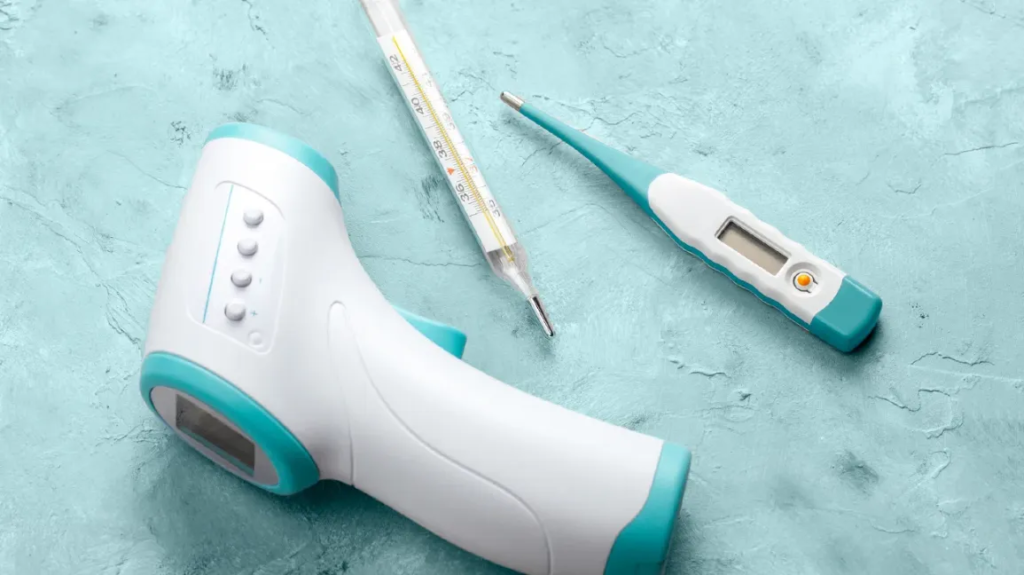GDA Nursing Class Notes 28

BODY TEMPERATURE :-
•Temperature is a degree of heat maintained by the body.
•It is the balance between the heat produced and heat lost.
Body temperature is the measure of how warm or cold the body is and is typically expressed in degrees Fahrenheit (°F) or degrees Celsius (°C). It is an essential physiological parameter because it can indicate the overall health and functioning of an individual’s body.
Normal Body Temperature: The average normal body temperature for a healthy adult is around 98.6°F (37°C).

THERMOMETER:-
•Thermometer is used to measure the body temperature
A thermometer is an instrument used to measure temperature or temperature changes. There are various types of thermometers, each with its own principle of operation and specific applications. The choice of thermometer depends on the specific application, accuracy requirements, temperature range, and other factors.

TYPES OF THERMOMETER:-
Mercury thermometer- Mercury thermometers consist of a glass tube filled with mercury. As the temperature changes, the mercury expands or contracts, and the height of the mercury column within the tube indicates the temperature. However, mercury thermometers are now less common due to the toxicity of mercury.

Digital thermometer- Digital thermometers use electronic sensors to measure temperature. They provide a numerical readout on a digital display. Digital thermometers are widely used for measuring body temperature, room temperature, and other applications due to their accuracy and ease of use.

Infrared thermometer- Infrared thermometers, also known as non-contact or laser thermometers, measure temperature from a distance without physical contact. They work by detecting the infrared radiation emitted by an object and converting it into a temperature reading. Infrared thermometers are often used for quick and non-invasive temperature measurements, such as for cooking, industrial processes, or medical purposes.

Parts of mercury thermometer:-
A mercury thermometer consists of several essential parts that work together to measure temperature accurately. Here are the main components of a traditional mercury thermometer:
- Glass Tube: The primary component of a mercury thermometer is a narrow glass tube. The tube is sealed at one end and open at the other. It is typically made of borosilicate glass, which can withstand temperature changes without breaking.
- Mercury Reservoir: The closed end of the glass tube contains a small bulb or reservoir that is filled with mercury. The amount of mercury used depends on the design and intended temperature range of the thermometer.
- Capillary Tube: Extending from the mercury reservoir is a capillary tube. This tube is very narrow and runs the length of the thermometer. It allows the mercury to expand or contract as the temperature changes, causing the level of mercury in the tube to rise or fall.
- Scale: The outside of the glass tube is marked with a temperature scale. The scale consists of evenly spaced markings or degrees, each representing a specific temperature value. Common temperature scales include Fahrenheit (°F) and Celsius (°C). The scale helps users read the temperature by observing the level of the mercury.
- Thermometer Bulb: The bulb is the rounded, closed end of the glass tube where the mercury is initially placed. This is the part of the thermometer that is exposed to the temperature being measured. As the temperature increases, the mercury expands and moves up the capillary tube.
- Kink: a sharp bend or constriction in the glass tube. This bend is deliberately introduced during the manufacturing process and serves a specific purpose in the functioning of the thermometer. The presence of a kink in a mercury thermometer serves an important function in maintaining accuracy and providing a reference point for temperature measurement.

Common sites:-
•Mouth
•Axilla
•Groin
•Vagina
•Rectum

Fever:-
Fever is a medical condition characterized by an elevated body temperature above the normal range. It is often a sign that the body is responding to an infection or other medical condition. It is defined as the rise in body temperature above 99F (37.2 C).

